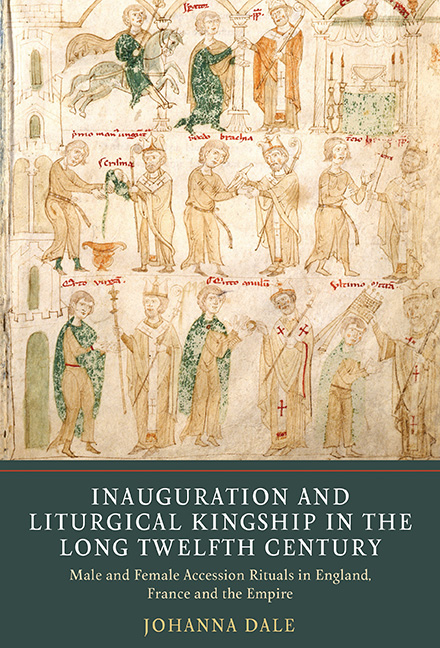 Inauguration and Liturgical Kingship in the Long Twelfth Century
Inauguration and Liturgical Kingship in the Long Twelfth Century Book contents
- Frontmatter
- Contents
- List of Illustrations
- Acknowledgements
- List of Abbreviations
- Timeline
- Genealogies
- Introduction
- 1 Liturgical Texts: The Spoken Word and Song
- 2 Liturgical Rituals: Rubrication and Regalia
- 3 Who and Where? Actors, Location and Legitimacy
- 4 What and When? Consecration and the Liturgical Calendar
- 5 Royal Titles, Anniversaries and their Meaning: The Charter Evidence
- 6 Seal Impressions and Christomimetic Kingship
- Conclusion
- Appendix 1 Editions and Manuscripts of the Selected Ordines
- Appendix 2 Prayer Formulae Incipits
- Appendix 3 Tables of Ritual Elements in the Ordines
- Appendix 4 Brief Descriptions of Royal and Imperial Seals and Bullae
- Bibliography
- Index of Biblical References
- General Index
- Frontmatter
- Contents
- List of Illustrations
- Acknowledgements
- List of Abbreviations
- Timeline
- Genealogies
- Introduction
- 1 Liturgical Texts: The Spoken Word and Song
- 2 Liturgical Rituals: Rubrication and Regalia
- 3 Who and Where? Actors, Location and Legitimacy
- 4 What and When? Consecration and the Liturgical Calendar
- 5 Royal Titles, Anniversaries and their Meaning: The Charter Evidence
- 6 Seal Impressions and Christomimetic Kingship
- Conclusion
- Appendix 1 Editions and Manuscripts of the Selected Ordines
- Appendix 2 Prayer Formulae Incipits
- Appendix 3 Tables of Ritual Elements in the Ordines
- Appendix 4 Brief Descriptions of Royal and Imperial Seals and Bullae
- Bibliography
- Index of Biblical References
- General Index
Summary
In 1975, in typically surreal fashion, the British comedy group Monty Python parodied that staple of medieval entertainment: Arthurian legend. In one scene, our hero approaches two peasants. One, inexplicably named Dennis and unaware of Arthur's identity, objects to the fact that Arthur automatically treats him as an inferior. Arthur justifies his haughty behaviour by replying that he is king. This does little to ameliorate Dennis's disgruntlement. At this point Dennis's female companion exclaims that she did not vote for Arthur to be king. ‘You don't vote for kings’, Arthur retorts incredulously. The peasant woman then asks how Arthur became king and he explains that the Lady of the Lake presented him with the sword Excalibur, signifying by divine providence that he should be king. This is too much for Dennis, who interjects with the memorable line that ‘strange women lying in ponds distributing swords is no basis for a system of government. Supreme executive power derives from a mandate from the masses, not from some farcical aquatic ceremony.’ In the inauguration ceremonies investigated in this book, swords played a prominent role, though they were bestowed on the monarch by men of the cloth rather than lake-dwelling fairies. The assent of the clergy and people was also a feature of medieval inaugurations, though twelfth-century kings could hardly have been described as having a mandate from the masses. Rather, the relevance of this scene from Monty Python and the Holy Grail to the subject matter of this book lies in the similarity between the impertinent peasants’ approach to King Arthur and the manner in which modern scholars have approached high medieval kingship.
While focusing on the rituals of royal and imperial inauguration, this book aims to contribute to a much wider debate about the nature of kingship in what has come to be seen as a transitional period. Like Dennis and his female companion, modern scholars have often assumed the inevitability of the modern secular state so that the liturgical trappings of high medieval kingship, particularly in England, have been treated simply as the ‘froth on top of serious government’. Inherent to the paradigm of modern state formation is the assumption that the sacrality of monarchy, and the spell of its divine providence, at some point wanes.
- Type
- Chapter
- Information
- Inauguration and Liturgical Kingship in the Long Twelfth CenturyMale and Female Accession Rituals in England, France and the Empire, pp. 1 - 25Publisher: Boydell & BrewerPrint publication year: 2019
